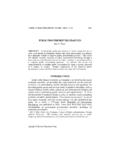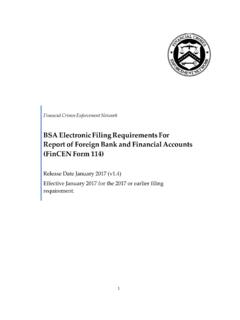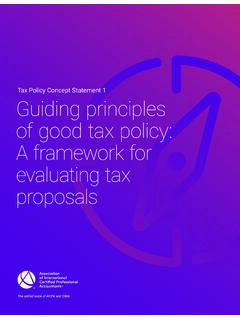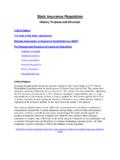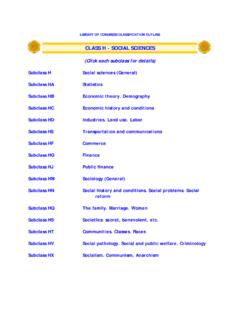Transcription of Causes of the Financial Crisis - Federation of American ...
1 CRS Report for CongressPrepared for Members and Committees of Congress Causes of the Financial Crisis Mark Jickling Specialist in Financial Economics April 9, 2010 Congressional Research Service7-5700 R40173 Causes of the Financial Crisis Congressional Research Service Summary The current Financial Crisis began in August 2007, when Financial stability replaced inflation as the Federal Reserve s chief concern. The roots of the Crisis go back much further, and there are various views on the fundamental Causes . It is generally accepted that credit standards in mortgage lending were relaxed in the early 2000s, and that rising rates of delinquency and foreclosures delivered a sharp shock to a range of Financial institutions.
2 Beyond that point of agreement, however, there are many questions that will be debated by policymakers and academics for decades. Why did the Financial shock from the housing market downturn prove so difficult to contain? Why did the tools the Fed used successfully to limit damage to the Financial system from previous shocks (the Asian crises of 1997-1998, the stock market crashes of 1987 and 2000-2001, the junk bond debacle in 1989, the savings and loan Crisis , 9/11, and so on) fail to work this time? If we accept that the origins are in the United States, why were so many Financial systems around the world swept up in the panic?
3 To what extent were long-term developments in Financial markets to blame for the instability? Derivatives markets, for example, were long described as a way to spread Financial risk more efficiently, so that market participants could bear only those risks they understood. Did derivatives, and other risk management techniques, actually increase risk and instability under Crisis conditions? Was there too much reliance on computer models of market performance? Did those models reflect only the post-WWII period, which may now come to be viewed not as a typical 60-year period, suitable for use as a baseline for Financial forecasts, but rather as an unusually favorable period that may not recur?
4 Did government actions inadvertently create the conditions for Crisis ? Did regulators fail to use their authority to prevent excessive risk-taking, or was their jurisdiction too limited and/or compartmentalized? The multiple roots of the Crisis are mirrored in the policy response. Two bills in the 111th Congress 4173, passed by the House on December 11, 2009, and Senator Dodd s Restoring American Financial Stability Act, as ordered reported by the Senate Banking Committee on March 22, 2010 address many of the purported causal factors across the entire Financial system.
5 The bills address systemic risk, too-big-to-fail, prudential supervision, hedge funds, derivatives, payments systems, credit rating agencies, securitization, and consumer Financial protection. (For a summary of major provisions, see CRS Report R40975, Financial Regulatory reform and the 111th Congress, coordinated by Baird Webel.) This report consists of a table that presents very briefly some of the arguments for particular Causes , presents equally brief rejoinders, and includes a reference or two for further reading. It will be updated as required by market developments.
6 Introduction The Financial Crisis that began in 2007 spread and gathered intensity in 2008, despite the efforts of central banks and regulators to restore calm. By early 2009, the Financial system and the global Causes of the Financial Crisis Congressional Research Service 4 economy appeared to be locked in a descending spiral, and the primary focus of policy became the prevention of a prolonged downturn on the order of the Great Depression. The volume and variety of negative Financial news, and the seeming impotence of policy responses, has raised new questions about the origins of Financial crises and the market mechanisms by which they are contained or propagated.
7 Just as the economic impact of Financial market failures in the 1930s remains an active academic subject, it is likely that the Causes of the current Crisis will be debated for decades to come. This report sets out in tabular form a number of the factors that have been identified as Causes of the Crisis . The left column of Tab le 1 below summarizes the causal role of each such factor. The next column presents a brief rejoinder to that argument. The right-hand column contains a reference for further reading. Where text is given in quotation marks, the reference in the right column is the source, unless otherwise specified.
8 CRS-5 Table 1. Causes of the Financial Crisis Cause Argument Rejoinder Additional Reading Imprudent Mortgage Lending Against a backdrop of abundant credit, low interest rates, and rising house prices, lending standards were relaxed to the point that many people were able to buy houses they couldn t afford. When prices began to fall and loans started going bad, there was a severe shock to the Financial system. Imprudent lending certainly played a role, but subprime loans (about $ trillion at the peak) were a relatively small part of the overall mortgage market (about $11 trillion) and of total credit market debt outstanding (about $50 trillion).
9 CRS Report RL33775, Alternative Mortgages: Causes and Policy Implications of Troubled Mortgage Resets in the Subprime and Alt-A Markets, by Edward V. Murphy. Housing Bubble With its easy money policies, the Federal Reserve allowed housing prices to rise to unsustainable levels. The Crisis was triggered by the bubble bursting, as it was bound to do. It is difficult to identify a bubble until it bursts, and Fed actions to suppress the bubble may do more damage to the economy than waiting and responding to the effects of the bubble bursting. CRS Report RL33666, Asset Bubbles: Economic Effects and Policy Options for the Federal Reserve, by Marc Labonte.
10 Global Imbalances Global Financial flows have been characterized in recent years by an unsustainable pattern: some countries (China, Japan, and Germany) run large surpluses every year, while others (like the and UK) run deficits. The external deficits have been mirrored by internal deficits in the household and government sectors. borrowing cannot continue indefinitely; the resulting stress underlies current Financial disruptions. None of the adjustments that would reverse the fundamental imbalances has yet occurred. That is, there has not been a sharp fall in the dollar s exchange value, and deficits persist.










